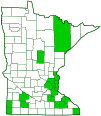spined assassin bug
(Sinea diadema)
Conservation • Description • Habitat • Ecology • Distribution • Taxonomy
Conservation Status |
|
|||||||
| IUCN Red List | not listed |
|||||||
| NatureServe | NNR - Unranked |
|||||||
| Minnesota | not listed |
|||||||
Description |
||
Spined assassin bug is one of the most common assassin bugs (family Reduviidae) in North America. It occurs from coast to coast in the United States, northern Mexico, and southern Canada. It is common and abundant in Minnesota. It is found in open sunny areas on grasses and herbaceous plants. Adults are dark brown, soft-bodied, oval, and ½″ to 9 ⁄16″ long. The head is small, elongated, and covered with spines. It is narrow when viewed from above, much narrower than the thorax, and oval when viewed from the side. The neck is long and turtle-like. There are two large, bulging, reddish-brown, compound eyes and two small simple eyes (ocelli). Between the compound eyes there is a distinct crosswise (transverse) groove. The antennae are exposed, conspicuous, slender, and long, much longer than the head but not as long as the body. They have four segments. The mouth parts are optimized for piercing and sucking, and take the form of a thick, curved, 3-segmented beak. The beak is longer than the head and fits into a groove on the underside of the sternum when not in use. The exoskeletal plate covering the thorax has two lobes. The front lobe is covered with long spines, the rear lobe is not. The abdomen is flat and much wider than the thorax. The sides of the abdomen are greatly expanded. On the expanded portion, there is a pale spot at the rear margin of each segment. On the female, the outer margin of the abdomen is wavy (undulate) with more or less angular lobes. On the male, the margin may be very prominently undulate or almost unlobed. There are two pairs of wings, and they are held flat over the body when at rest. Between and at the wing bases there is a triangular plate (scutellum). The forewings (hemelytra) on the mature adult are longer than the abdomen but do not cover the expanded sides of the abdomen. They have a thickened section at the base and a thin membranous section at the tip with a clear dividing line between the two. The thickened basal part is comprised of a narrow area (clavus) behind the scutellum when the wings are closed, and the remaining broad marginal area (corium). At the end of the corium there is a small but distinct triangular area (cuneus). There are no obvious short veins at the outer margin of the membranous section. The hindwings are thin, membranous, and concealed under the forewings. The legs are long and gangly. The third segment (femur) on the front leg is thickened and is covered with long spines above. The end part of the leg, corresponding to the foot, (tarsus) has 3 segments. The nymph resembles the adult but has no wings. |
||
Size |
||
Total length: ½″ to 9 ⁄16″ |
||
Similar Species |
||
| Spiny assassin bug (Sinea spinipes) head is less spiny. The front part of the pronotum has blunt projections only, no sharp spines. | ||
Habitat |
||
Grasslands, fields, gardens |
||
Ecology |
||
Season |
||
Two generations per year. Late May to mid-July and early September to early October |
||
Behavior |
||
|
||
Life Cycle |
||
The female lays about 361 eggs in small clusters of usually about 11 but up to 27. The eggs are cylinder-shaped with curved sides, a flared collar, and a cap at the top. They are deposited upright, usually arranged in two rows, on a leaf or in the soil. There are two generation per year. First stage (instar) nymphs of the first generation emerge in mid- to late April. Nymphs are found from mid-April to mid-September. They pass through five stages (instars) before emerging as adults. Adults emerge in late May and are active until mid-July. Second generation adults are active from early September to early October. Second generation eggs overwinter. |
||
Nymph Food |
||
|
||
Adult Food |
||
A wide variety of insects, including flies, bees, and caterpillars |
||
Distribution |
||||
|
Sources |
|||
| 8/21/2022 | ||||
Occurrence |
||||
Common and abundant |
||||
Taxonomy |
|||
Order |
Hemiptera (True bugs, Hoppers, Aphids, and Allies) | ||
Suborder |
Heteroptera (True Bugs) | ||
Infraorder |
Cimicomorpha | ||
Superfamily |
Reduvioidea | ||
Family |
Reduviidae (assassin bugs) | ||
Subfamily |
Harpactorinae | ||
Tribe |
Harpactorini | ||
Genus |
Sinea | ||
Synonyms |
|||
Sinea multispinosa Sinea undulata |
|||
Common Names |
|||
spined assassin bug |
|||
Glossary
Beak
In plants: A comparatively short and stout, narrow or prolonged tip on a thickened organ, as on some fruits and seeds. In insects: The protruding, tubular mouthpart of a sucking insect.
Femur
On insects and arachnids, the third, largest, most robust segment of the leg, coming immediately before the tibia. On humans, the thigh bone.
Hemelytron
The forewing of true bugs (order Hemiptera), thickened at the base and membranous at the tip. Plural: hemelytra.
Instar
The developmental stage of arthropods between each molt; in insects, the developmental stage of the larvae or nymph.
Ocellus
Simple eye; an eye with a single lens. Plural: ocelli.
Scutellum
The exoskeletal plate covering the rearward (posterior) part of the middle segment of the thorax in some insects. In Coleoptera, Hemiptera, and Homoptera, the dorsal, often triangular plate behind the pronotum and between the bases of the front wings. In Diptera, the exoskeletal plate between the abdomen and the thorax.
Tarsus
The last two to five subdivisions of an insect’s leg, attached to the tibia; the foot. Plural: tarsi.
Visitor Photos |
|||||
Share your photo of this insect. |
|||||
| This button not working for you? Simply email us at info@MinnesotaSeasons.com. Attach one or more photos and, if you like, a caption. |
|||||
Mike Poeppe |
|||||
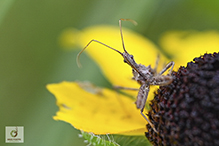 |
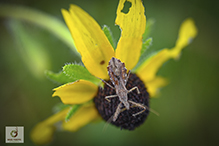 |
||||
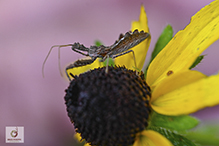 |
|||||
Alfredo Colon |
|||||
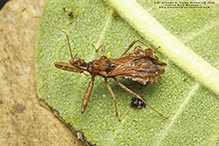 |
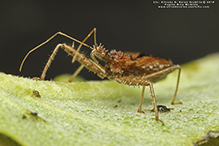 |
||||
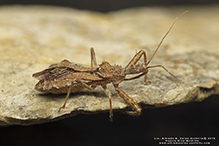 |
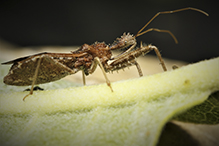 |
||||
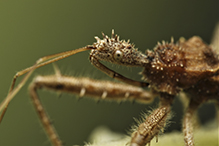 |
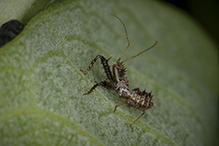 |
||||
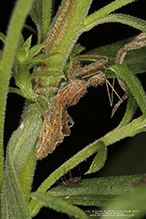 |
|||||
MinnesotaSeasons.com Photos |
|||||
|
|||||

Slideshows |
||

Visitor Videos |
|||
Share your video of this insect. |
|||
| This button not working for you? Simply email us at info@MinnesotaSeasons.com. Attach a video, a YouTube link, or a cloud storage link. |
|||
Other Videos |
|||
| Spined Assassin Bug (Reduviidae: Sinea diadema) on Milkweed Carl Barrentine |
|||
About
Published on Aug 13, 2010 hotographed at the Turtle River State Park, North Dakota (11 August 2010). |
|||


Last Updated:
